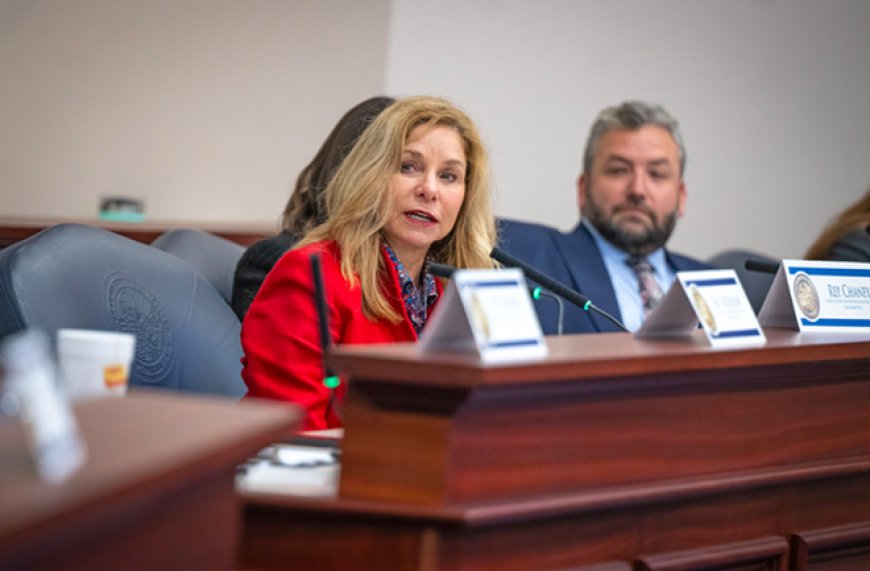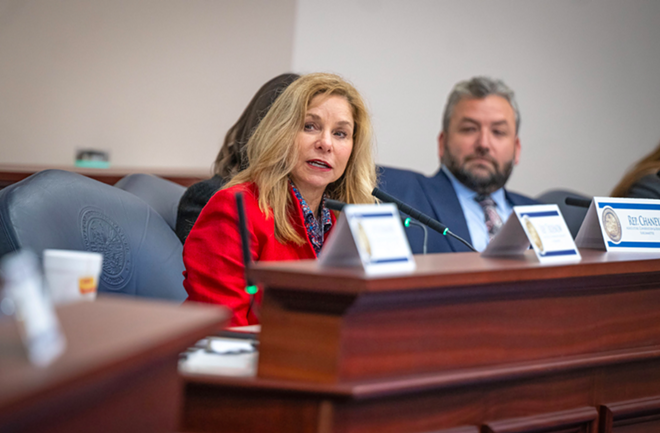A Tampa Bay Republican and a billionaire-backed conservative think tank are working together to roll back child labor laws
A Tampa Bay Republican and a billionaire-backed conservative think tank are working together to roll back child labor ... Creative Loafing Tampa

A Conservative Think Tank’s Efforts to Roll Back Child Labor Laws in Florida

Photo via Florida House
Rep. Linda Chaney, R-St. Pete Beach
A conservative think tank in Florida has been lobbying Republicans in state legislatures across the country to relax child labor laws. Now, it has been revealed that the same think tank has written legislation to achieve a similar aim in Florida.
Florida Republican Files Bill to Loosen Child Labor Regulations
A bill filed in September by Florida Republican Linda Chaney, a member of the state House, would undo decades of child labor regulations by loosening restrictions on how late older teens in Florida can work. It would also prevent local governments from passing limitations stricter than the state’s. This bill aligns with a growing movement to roll back labor regulations established to protect the health and safety of children.
Labor advocates have suspected that the Foundation for Government Accountability (FGA), a Naples-based group that has drafted legislation to roll back child labor laws in other states, is behind Chaney’s bill. Public records, including emails and text messages, now prove this suspicion.
FGA’s Involvement in Writing the Bill
Emails show that the FGA, a dark money group funded by ultra-conservatives and a billionaire mega-donor, not only supports Chaney’s bill but also wrote it themselves. They provided Chaney with talking points to counter the backlash the bill quickly received.
Chaney’s legislative aide began communicating with the FGA over email about “Youth Worker Freedom” legislation in late July. The aide’s initial email shows that this communication came at the request of Chaney herself. The draft legislation sent to Chaney is nearly identical to the bill as it was originally filed in September.
Impact and Concerns
The bill, if passed, would loosen restrictions on the working hours of 16-year-olds and 17-year-olds in Florida. While it may not legalize hazardous work for minors, child experts warn that working more than 20 hours per week can have negative effects on academic performance and increase the risk of behavioral problems.
Child Labor Violations in Florida
Child labor violations in Florida have been on the rise. According to the U.S. Department of Labor, Florida had 281 child labor violations in 2022, up from 178 in 2021. From 2019 to 2022, child labor violations nearly tripled, from 95 in 2019 to 281 in 2022.
Opposition and Lobbying Efforts
The FGA’s Opportunity Solutions Project has hired over 116 lobbyists across more than two dozen states since 2016. Lobbying expenditures in Florida alone have exceeded $500,000. The group has also fought against efforts to expand Medicaid and has supported tightening eligibility requirements for food stamps and undermining labor unions.
Concerns About Weakening Protections
The Biden administration is working to crack down on child labor violations, but advocates worry that proposed changes to state laws, like the one in Florida, are part of a long-term project to weaken already substandard regulations under the federal Fair Labor Standards Act.
Conclusion
The FGA’s efforts to roll back child labor laws in Florida raise concerns about the well-being and safety of children. The proposed bill, if passed, would have significant implications for the working conditions and rights of young workers in the state. It is important to consider the Sustainable Development Goals (SDGs), particularly Goal 8: Decent Work and Economic Growth, which aims to promote inclusive and sustainable economic growth, full and productive employment, and decent work for all.
SDGs, Targets, and Indicators Analysis
1. Which SDGs are addressed or connected to the issues highlighted in the article?
- SDG 4: Quality Education
- SDG 8: Decent Work and Economic Growth
- SDG 10: Reduced Inequalities
- SDG 16: Peace, Justice, and Strong Institutions
The article addresses issues related to child labor regulations, which are connected to several SDGs. SDG 4 focuses on quality education and ensuring that all children have access to education. Child labor can hinder children’s access to education and their ability to develop academically. SDG 8 aims to promote decent work and economic growth, including protecting the rights of workers, which is relevant to the discussion on child labor regulations. SDG 10 focuses on reducing inequalities, including addressing inequalities in the labor market and protecting vulnerable groups such as children. SDG 16 aims to promote peace, justice, and strong institutions, including ensuring the protection of children’s rights and preventing exploitation.
2. What specific targets under those SDGs can be identified based on the article’s content?
- Target 4.1: By 2030, ensure that all girls and boys complete free, equitable, and quality primary and secondary education leading to relevant and effective learning outcomes.
- Target 8.7: Take immediate and effective measures to eradicate forced labor, end modern slavery and human trafficking, and secure the prohibition and elimination of the worst forms of child labor.
- Target 10.2: By 2030, empower and promote the social, economic, and political inclusion of all, irrespective of age, sex, disability, race, ethnicity, origin, religion, or economic or other status.
- Target 16.2: End abuse, exploitation, trafficking, and all forms of violence against and torture of children.
Based on the article’s content, the targets identified are relevant to the issues discussed. Target 4.1 emphasizes the importance of ensuring that children have access to quality education, which can be hindered by child labor. Target 8.7 focuses on eradicating forced labor and the worst forms of child labor, aligning with the concerns raised about rolling back child labor regulations. Target 10.2 highlights the need to promote the inclusion of all individuals, including children, in social, economic, and political spheres. Target 16.2 emphasizes the importance of ending abuse and exploitation of children, including child labor.
3. Are there any indicators mentioned or implied in the article that can be used to measure progress towards the identified targets?
- Indicator 4.1.1: Proportion of children and young people (a) in grades 2/3; (b) at the end of primary; and (c) at the end of lower secondary achieving at least a minimum proficiency level in (i) reading and (ii) mathematics, by sex.
- Indicator 8.7.1: Number of victims of forced labor per 1,000 persons aged 18 years and older.
- Indicator 10.2.1: Proportion of people living below 50 percent of median income, by age, sex, and persons with disabilities.
- Indicator 16.2.2: Number of victims of human trafficking per 100,000 population, by sex, age group, and form of exploitation.
The article does not explicitly mention indicators, but based on the identified targets, the following indicators can be used to measure progress. Indicator 4.1.1 measures the proficiency level of children and young people in reading and mathematics, which can reflect their access to quality education. Indicator 8.7.1 measures the number of victims of forced labor, which includes child labor, per 1,000 persons aged 18 years and older. Indicator 10.2.1 measures the proportion of people living below 50 percent of median income, which can indicate inequalities in economic inclusion, including for children. Indicator 16.2.2 measures the number of victims of human trafficking, which includes child trafficking, per 100,000 population.
SDGs, Targets, and Indicators Table
| SDGs | Targets | Indicators |
|---|---|---|
| SDG 4: Quality Education | Target 4.1: By 2030, ensure that all girls and boys complete free, equitable, and quality primary and secondary education leading to relevant and effective learning outcomes. | Indicator 4.1.1: Proportion of children and young people (a) in grades 2/3; (b) at the end of primary; and (c) at the end of lower secondary achieving at least a minimum proficiency level in (i) reading and (ii) mathematics, by sex. |
| SDG 8: Decent Work and Economic Growth | Target 8.7: Take immediate and effective measures to eradicate forced labor, end modern slavery and human trafficking, and secure the prohibition and elimination of the worst forms of child labor. | Indicator 8.7.1: Number of victims of forced labor per 1,000 persons aged 18 years and older. |
| SDG 10: Reduced Inequalities | Target 10.2: By 2030, empower and promote the social, economic, and political inclusion of all, irrespective of age, sex, disability, race, ethnicity, origin, religion, or economic or other status. | Indicator 10.2.1: Proportion of people living below 50 percent of median income, by age, sex, and persons with disabilities. |
| SDG 16: Peace, Justice, and Strong Institutions | Target 16.2: End abuse, exploitation, trafficking, and all forms of violence against and torture of children. | Indicator 16.2.2: Number of victims of human trafficking per 100,000 population, by sex, age group, and form of exploitation. |
Behold! This splendid article springs forth from the wellspring of knowledge, shaped by a wondrous proprietary AI technology that delved into a vast ocean of data, illuminating the path towards the Sustainable Development Goals. Remember that all rights are reserved by SDG Investors LLC, empowering us to champion progress together.
Source: cltampa.com

Join us, as fellow seekers of change, on a transformative journey at https://sdgtalks.ai/welcome, where you can become a member and actively contribute to shaping a brighter future.







